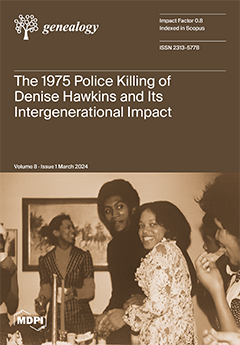In the introduction to her influential work on Asian American cultural studies and feminist materialist critique,
Immigrant Acts: On Asian American Cultural Politics, Lisa Lowe shatters the contradictions manifested in Asian immigration, wherein Asians’ entry into the United States marked them either
[...] Read more.
In the introduction to her influential work on Asian American cultural studies and feminist materialist critique,
Immigrant Acts: On Asian American Cultural Politics, Lisa Lowe shatters the contradictions manifested in Asian immigration, wherein Asians’ entry into the United States marked them either as marginalized from “within” the national political sphere or as linguistically, culturally, and racially “outside” of the national polity For Asian immigrants, the debate of being simultaneously needed and excluded is no more evidenced historically than using Chinese labor during the California Gold Rush in the mid-nineteenth century. Their migratory relocation was hardly met with ease and public enthusiasm, however. Evoking anxiety in their Anglo counterparts, the Chinese were characterized as foreign noncitizens: barbaric, alien, and dangerous, the quintessential “yellow peril” threatening to displace white European immigrants such as the Irish. The irrational fear of the “Oriental” from the Far East led to a succession of immigration exclusion laws passed by Congress that denied the Chinese from entering the U.S. and their rights to naturalization in 1882. Passed by Congress and signed by President Chester A. Arthur, the 1882 Chinese Exclusion Act suspended the entry of Chinese laborers into the U.S. based on their nationality for ten years. This paper argues that the possibility of agency for Chinese workers existed throughout the exclusionary period. Specifically, this site of agency resides with Chinese women and is expressed through a literary mode. For instance, Lin Yutang’s
Chinatown Family (1948) captures this moment of immigrant agency in the post-exclusion era. Lin, a pioneering Chinese writer and inventor who wrote texts such as
My Country and My People (1935),
The Importance of Living (1937), and
Moment in Peking (1939), often utilized his narratives to bridge the clash between the East and West. Identifying what I see as the inadequacy of probing one of the earliest Chinese American texts from a rigid literary mode, I move to reconsider the novel as a legal counternarrative to the three exclusionary laws: the Page Law of 1875, the Chinese Exclusion Act of 1882, and the Cable Act of 1922. To direct my critical reorientation of Lin’s novel
away from, though not necessarily
against, literary castings of this early immigrant tale, I take the narrative as a strategic literary re-imagination that structures itself around these three legislative pieces to critique restrictive practices enacted upon the Chinese. The novel showcases how Chinese immigrants maneuvered and manipulated the legal system in their favor during assimilation. In this context, critical reappraisal is needed in scrutinizing how the Exclusion Act generated a wave of domestic-based diasporic relocation of Chinese workers from California to New York. Due to acute anti-Chinese sentiments on the West Coast, resetting Chinese workers in the northeast in search of a new Gold Mountain led to a unique phenomenon. This dispersal elevated Chinese women as valuable social capitals who transformed metropoles like New York City and redefined their views as nationalist subjects of the “about-to-be” in industrial capitalist modernity. Through a legal framework, then, Lin’s portrayal of the Fong clan suggests the emergence of a gendered Sino-immigrant agency, one that enabled the Chinese woman/mother to situate herself as the locus of the traditional patriarchal Chinese entrepreneurial family and the forefront of the northeast industrial capitalist scene.
Full article





